
Weinsberg
Encyclopedia
Weinsberg is a town in the north of the German
state
Baden-Württemberg
. It was founded ca. 1200 and is situated in the Heilbronn
district. The town has about 11,800 inhabitants. It is noted for its wine. The town's name itself is derived from the German word "Weinberg", which means "vineyard".
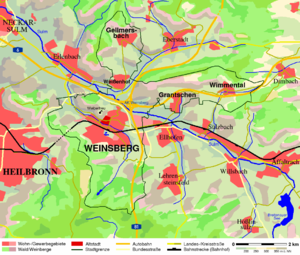 Northwest of the town centre rises the Burgberg, with the ruins of Weibertreu castle, west of it the Scheuerberg. Both mountains are used intensively for viticulture. In the east extends the Sulm valley, south the cultivated area are the Stadtseebach valley and the Brühl valley. In the south and the west the city borders on the Heilbronn mountains, which are wooded foothills of the Löwenstein mountains. They begin in the east with the Reisberg and extend over the Hintersberg and the Waldheide up to the Galgenberg and the Wartberg in the west. On the Wartberg the valley of the Stadtseebach continues, north of it the Schemelsberg mentioned above in the northwest.
Northwest of the town centre rises the Burgberg, with the ruins of Weibertreu castle, west of it the Scheuerberg. Both mountains are used intensively for viticulture. In the east extends the Sulm valley, south the cultivated area are the Stadtseebach valley and the Brühl valley. In the south and the west the city borders on the Heilbronn mountains, which are wooded foothills of the Löwenstein mountains. They begin in the east with the Reisberg and extend over the Hintersberg and the Waldheide up to the Galgenberg and the Wartberg in the west. On the Wartberg the valley of the Stadtseebach continues, north of it the Schemelsberg mentioned above in the northwest.
The Sulm valley in the north of the Schemelsberg becomes dominated by the A 6
, which meets the A 81
by the Weinsberg interchange in the north-east of the town. North of the Sulmtal continues the wooded Sulmer Bergebene. The A 81 towards Stuttgart runs approximately along the eastern boundary border of Weinsberg.
The lowest point of the boundary lies at the Sulm with 166 m elevation. The highest point lies on the northern slope of the Reisberg at the southeast boundary border to Heilbronn with 338 m elevation.
 Weinsberg is situated on the edge of a Keuper
Weinsberg is situated on the edge of a Keuper
area of the Löwenstein mountains, whose foothills extend until Neckarsulm
and Öhringen
. The Burgberg and Schemelsberg are butte
s being separated by Sulm and Stadtseebach from the remaining mountain stick. Both have a stratum of sand stone, which was used both for the Weibertreu Castle and the Johanneskirche. At the Burgberg from 1811 to 1867 gypsum
was reduced. The hole being left by the gypsum dismantling in the mountain was filled up again in the 1950s and converted into vineyards of the local viticulture school.
In former times in the periphery of Weinsberg ten quarries were operated. In Weinsberg there were quarries at the southwest border to Heilbronn as well as on the Burgberg (the last one very small).
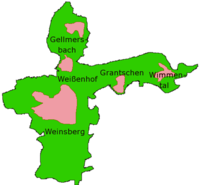
By the incorporations the form of the communal land can be compared with an irregular (Greek) cross, whereby Weinsberg represents the short west and the thickened south bar. Gellmersbach represents the north bar; Grantschen and Wimmental represent the extended east bar. The expansion in north-south direction amounts to about 8.6 km, in west-east direction about 9.3 km. In 1957 as well as 1988-2004 the land use distributed itself as follows: (Area specifications in ha, source 1957:; 1988–2004:'):
traffic surface
|155.9
|10.90
|515
|23.2
|546
|24.6
|567
|25.5
|595
|26.8
|615
|27.7
|-align="right"
|align="left" bgcolor="#e0e0e0"|Agricultural surface
|750.9
|52.50
|1,186
|53.4
|1,122
|50.5
|1,100
|49.5
|1,068
|48.1
|1,048
|47.1
|-align="right"
|align="left" bgcolor="#e0e0e0" |Forest surface
|496.1
|34.70
|494
|22.2
|529
|23.8
|529
|23.8
|528
|23.8
|528
|23.7
|-align="right"
|align="left" bgcolor="#e0e0e0"|Water surface
|6.5
|0.45
|10
|0.5
|12
|0.5
|12
|0.5
|13
|0.6
|13
|0.6
|-align="right"
|align="left" bgcolor="#e0e0e0"|Remaining surface
|19.6
|1.37
|17
|0.8
|13
|0.6
|14
|0.6
|17
|0.8
|18
|0.8
|}
Germany
Germany , officially the Federal Republic of Germany , is a federal parliamentary republic in Europe. The country consists of 16 states while the capital and largest city is Berlin. Germany covers an area of 357,021 km2 and has a largely temperate seasonal climate...
state
States of Germany
Germany is made up of sixteen which are partly sovereign constituent states of the Federal Republic of Germany. Land literally translates as "country", and constitutionally speaking, they are constituent countries...
Baden-Württemberg
Baden-Württemberg
Baden-Württemberg is one of the 16 states of Germany. Baden-Württemberg is in the southwestern part of the country to the east of the Upper Rhine, and is the third largest in both area and population of Germany's sixteen states, with an area of and 10.7 million inhabitants...
. It was founded ca. 1200 and is situated in the Heilbronn
Heilbronn (district)
Heilbronn is a district in the north of Baden-Württemberg, Germany. Neighboring districts are Neckar-Odenwald, Hohenlohe, Schwäbisch Hall, Rems-Murr, Ludwigsburg, Enz, Karlsruhe and Rhein-Neckar...
district. The town has about 11,800 inhabitants. It is noted for its wine. The town's name itself is derived from the German word "Weinberg", which means "vineyard".
Geographical position
Weinsberg lies in the eastern Heilbronn district in the northeast part of Baden-Wuerttemberg, between the Neckar in the west and the Löwenstein mountains in the east. The small river Sulm rises from the Löwenstein mountains and flows into the Neckar after approximately 20 km. The valley formed of the Sulm and its tributaries is called Weinsberger Tal. The city mainly lies in and on the tendencies of the valley of the Stadtseebach (also called Saubach), a southern tributary of the Sulm. The Sulm flows by Weinsberg's area, but not by the city itself, and only a small northern part of the city lies at the edge of the Sulm valley.
The Sulm valley in the north of the Schemelsberg becomes dominated by the A 6
Bundesautobahn 6
, also known as Via Carolina is a 477 km long German autobahn. It starts at the French border near Saarbrücken in the west and end at the Czech border near Waidhaus in the east....
, which meets the A 81
Bundesautobahn 81
is a motorway in Germany. It branches off the A 3 at the Würzburg-West triangle and ends near the border to Switzerland.The oldest part of the A 81 between the Weinsberg intersection near Heilbronn and the Leonberg triangle near Stuttgart was finished in the years 1938 to 1940...
by the Weinsberg interchange in the north-east of the town. North of the Sulmtal continues the wooded Sulmer Bergebene. The A 81 towards Stuttgart runs approximately along the eastern boundary border of Weinsberg.
The lowest point of the boundary lies at the Sulm with 166 m elevation. The highest point lies on the northern slope of the Reisberg at the southeast boundary border to Heilbronn with 338 m elevation.
Geology

Late Triassic
The Late Triassic is in the geologic timescale the third and final of three epochs of the Triassic period. The corresponding series is known as the Upper Triassic. In the past it was sometimes called the Keuper, after a German lithostratigraphic group that has a roughly corresponding age...
area of the Löwenstein mountains, whose foothills extend until Neckarsulm
Neckarsulm
Neckarsulm is a city in northern Baden-Württemberg, Germany, near Stuttgart, and part of the district Heilbronn. As of 2004, Neckarsulm had 27,296 inhabitants....
and Öhringen
Öhringen
Öhringen is the largest city in Hohenlohe in the state of Baden-Württemberg, in southwest Germany, near Heilbronn. Öhringen is on the railways to Schwäbisch Hall and Crailsheim.With a population of 22,745 , the city is diverse...
. The Burgberg and Schemelsberg are butte
Butte
A butte is a conspicuous isolated hill with steep, often vertical sides and a small, relatively flat top; it is smaller than mesas, plateaus, and table landform tables. In some regions, such as the north central and northwestern United States, the word is used for any hill...
s being separated by Sulm and Stadtseebach from the remaining mountain stick. Both have a stratum of sand stone, which was used both for the Weibertreu Castle and the Johanneskirche. At the Burgberg from 1811 to 1867 gypsum
Gypsum
Gypsum is a very soft sulfate mineral composed of calcium sulfate dihydrate, with the chemical formula CaSO4·2H2O. It is found in alabaster, a decorative stone used in Ancient Egypt. It is the second softest mineral on the Mohs Hardness Scale...
was reduced. The hole being left by the gypsum dismantling in the mountain was filled up again in the 1950s and converted into vineyards of the local viticulture school.
In former times in the periphery of Weinsberg ten quarries were operated. In Weinsberg there were quarries at the southwest border to Heilbronn as well as on the Burgberg (the last one very small).

Area
The town of Weinsberg covers 22.22 km², about 13.95 km² of which are allotted to Weinsberg, 3.36 km² to Gellmersbach, 2.10 km² to Grantschen and 2.79 km² to Wimmental (conditions: June 2006)..By the incorporations the form of the communal land can be compared with an irregular (Greek) cross, whereby Weinsberg represents the short west and the thickened south bar. Gellmersbach represents the north bar; Grantschen and Wimmental represent the extended east bar. The expansion in north-south direction amounts to about 8.6 km, in west-east direction about 9.3 km. In 1957 as well as 1988-2004 the land use distributed itself as follows: (Area specifications in ha, source 1957:; 1988–2004:'):
traffic surface
|155.9
|10.90
|515
|23.2
|546
|24.6
|567
|25.5
|595
|26.8
|615
|27.7
|-align="right"
|align="left" bgcolor="#e0e0e0"|Agricultural surface
|750.9
|52.50
|1,186
|53.4
|1,122
|50.5
|1,100
|49.5
|1,068
|48.1
|1,048
|47.1
|-align="right"
|align="left" bgcolor="#e0e0e0" |Forest surface
|496.1
|34.70
|494
|22.2
|529
|23.8
|529
|23.8
|528
|23.8
|528
|23.7
|-align="right"
|align="left" bgcolor="#e0e0e0"|Water surface
|6.5
|0.45
|10
|0.5
|12
|0.5
|12
|0.5
|13
|0.6
|13
|0.6
|-align="right"
|align="left" bgcolor="#e0e0e0"|Remaining surface
|19.6
|1.37
|17
|0.8
|13
|0.6
|14
|0.6
|17
|0.8
|18
|0.8
|}
The settlement surface increases continuously, since Weinsberg still proves construction sites. Conversely the agriculturally used surface decreases.

Gemmingen
Gemmingen is a town in the district of Heilbronn in Baden-Württemberg in southern Germany....
, which was acquired on 29 July 1936, as reconciliation for Weinsberg's area deliveries to the state for military purposes (extension of Heilbronn's drilling place on the Waldheide).
Neighbouring municipalities
Neighboring municipalities of Weinsberg are (clockwise from the west): the city HeilbronnHeilbronn
Heilbronn is a city in northern Baden-Württemberg, Germany. It is completely surrounded by Heilbronn County and with approximately 123.000 residents, it is the sixth-largest city in the state....
(Stadtkreis
Independent city
An independent city is a city that does not form part of another general-purpose local government entity. These type of cities should not be confused with city-states , which are fully sovereign cities that are not part of any other sovereign state.-Historical precursors:In the Holy Roman Empire,...
) and the municipalities Erlenbach
Erlenbach, Baden-Württemberg
Erlenbach is a municipality in the district of Heilbronn in Baden-Württemberg in southern Germany.-Geography:Erlenbach lies at the foot of the 317 meter tall Kayberg in the lower Sulmtal in the eastern part of district of Heilbronn....
, Eberstadt
Eberstadt
Eberstadt is a municipality in the district of Heilbronn, Baden-Württemberg, Germany. It is best known for its winegrowing and its yearly international high jump meeting .-External links:*...
, Bretzfeld
Bretzfeld
Bretzfeld is a municipality in the Hohenlohe district, in Baden-Württemberg, Germany. It is located 17 km east of Heilbronn....
(Hohenlohekreis), Obersulm
Obersulm
Obersulm is a municipality in the district of Heilbronn, Baden-Württemberg, Germany, formed in the 1970-s as a merger of the formerly independent municipalities Affaltrach, Eichelberg, Eschenau, Sülzbach, Weiler, and Willsbach. It is situated 12 km east of Heilbronn...
, Ellhofen
Ellhofen
Ellhofen is a town in the district of Heilbronn in Baden-Württemberg in southern Germany....
and Lehrensteinsfeld
Lehrensteinsfeld
Lehrensteinsfeld is a town in the district of Heilbronn in Baden-Württemberg in Germany....
. With the exception of Heilbronn and Bretzfeld all belong to the district of Heilbronn
Heilbronn (district)
Heilbronn is a district in the north of Baden-Württemberg, Germany. Neighboring districts are Neckar-Odenwald, Hohenlohe, Schwäbisch Hall, Rems-Murr, Ludwigsburg, Enz, Karlsruhe and Rhein-Neckar...
. Together with Eberstadt, Ellhofen and Lehrensteinsfeld Weinsberg has combined to form a joint association of administrations called „Raum Weinsberg“ seated in Weinsberg.
| Part | Incorporation | Inhabitants | Surface |
|---|---|---|---|
| Weinsberg | – | 9040 | 13.95 km² |
| Gellmersbach | January 1, 1975 | 921 | 3.36 km² |
| Grantschen | January 1, 1973 | 819 | 2.10 km² |
| Wimmental | January 1, 1975 | 610 | 2.79 km² |
Town structure
Except from the town itself, Weinsberg consists of the incorporated localities of Gellmersbach, Grantschen and Wimmental. Outside of the closed land development are the places Weißenhof (with clinical center), Rappenhof and Stöcklesberg belonging to Weinsberg, without it dealing thereby with own localities. Gone off no longer existing places on Weinsberg's communal land are Bodelshofen, Burkhardswiesen (or Burchardeswiesen), Holßhofen, In dem Gründe, Lyndach, Uff the Wier and Wolfshöfle.Climate

According to annual reports of the viticulture school Weinsberg, the average yearly temperature during 1961-1990 was 9.6 °C, the annual precipitation was about 740 mm. Values for the period 1971-2000 are 738.4 mm at 10.0 °C and 2002 11.1 °C at 959 mm. January from 1961 to 1990 had on the average 0.6 °C at 57 mm precipitation, 1971-2000 1.4 °C at 51.7 mm and 2002 0.8 °C at 21 mm. July had from 1961 to 1990 on the average 18.7 °C at 65 mm precipitation, 1971-2000 19.2 °C at 74.5 mm and 2002 18.8 °C at 92 mm.
According to meteorological data of the viticulture school the average yearly temperature in Weinsberg increased from 1900 to 2006 from 9.2 °C to 10 °C.
History
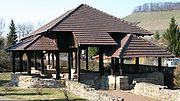
Prehistory and antiquity
The earliest known settlement trace in Weinsberg is a group of tumuliTumulus
A tumulus is a mound of earth and stones raised over a grave or graves. Tumuli are also known as barrows, burial mounds, Hügelgrab or kurgans, and can be found throughout much of the world. A tumulus composed largely or entirely of stones is usually referred to as a cairn...
. They're situated in the forest near the boundary to Heilbronn and haven't been investigated so far. It is assumed that the tumuli are to be assigned to the Hallstatt culture
Hallstatt culture
The Hallstatt culture was the predominant Central European culture from the 8th to 6th centuries BC , developing out of the Urnfield culture of the 12th century BC and followed in much of Central Europe by the La Tène culture.By the 6th century BC, the Hallstatt culture extended for some...
.
In the 19th century there was found a Celtic silver coin from the 2nd century BC. Its inscription "V, O, L, C“ can be assigned to the Celtic tribe of the Volcae
Volcae
The Volcae were a tribal confederation constituted before the raid of combined Gauls that invaded Macedon circa 270 BC and defeated the assembled Greeks at the Battle of Thermopylae in 279 BC...
, which lived (among other places) in Southern Germany at that time. So it can be assumed that Celts lived at least occasionally in the area of today's Weinsberg.
However, the first solidly attested settlers in the area of Weinsberg were the Romans. In the 2nd century, a Roman road
Roman road
The Roman roads were a vital part of the development of the Roman state, from about 500 BC through the expansion during the Roman Republic and the Roman Empire. Roman roads enabled the Romans to move armies and trade goods and to communicate. The Roman road system spanned more than 400,000 km...
led through today's town, running from the Böckingen castellet (belonging to the Neckar Limes
Limes
A limes was a border defense or delimiting system of Ancient Rome. It marked the boundaries of the Roman Empire.The Latin noun limes had a number of different meanings: a path or balk delimiting fields, a boundary line or marker, any road or path, any channel, such as a stream channel, or any...
) to the Öhringen castellet (belonging to the Limes Germanicus
Limes Germanicus
The Limes Germanicus was a line of frontier fortifications that bounded the ancient Roman provinces of Germania Inferior, Germania Superior and Raetia, dividing the Roman Empire and the unsubdued Germanic tribes from the years 83 to about 260 AD...
). Between 148 and 161 AD, a Roman villa rustica
Villa rustica
Villa rustica was the term used by the ancient Romans to denote a villa set in the open countryside, often as the hub of a large agricultural estate . The adjective rusticum was used to distinguish it from an urban or resort villa...
was established on this road, which existed until its destruction by the Alamanni
Alamanni
The Alamanni, Allemanni, or Alemanni were originally an alliance of Germanic tribes located around the upper Rhine river . One of the earliest references to them is the cognomen Alamannicus assumed by Roman Emperor Caracalla, who ruled the Roman Empire from 211 to 217 and claimed thereby to be...
in 234 or 259/260. The bath house of this manor (known in Weinsberg as Römerbad, i.e. "Roman bath") was excavated and conserved in 1906; parts of the remaining manor followed in 1977.
Middle Ages
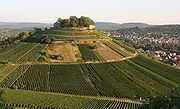
Franks
The Franks were a confederation of Germanic tribes first attested in the third century AD as living north and east of the Lower Rhine River. From the third to fifth centuries some Franks raided Roman territory while other Franks joined the Roman troops in Gaul. Only the Salian Franks formed a...
, who settled on Weinsberg's communal land between Erlenbach and Gellmersbach in the 7th century. In 778 the area around Weinsberg was first mentioned as "Sulmanachgowe" in a deed of donation of Charlemagne
Charlemagne
Charlemagne was King of the Franks from 768 and Emperor of the Romans from 800 to his death in 814. He expanded the Frankish kingdom into an empire that incorporated much of Western and Central Europe. During his reign, he conquered Italy and was crowned by Pope Leo III on 25 December 800...
to the Lorsch Abbey
Lorsch Abbey
The Abbey of Lorsch is a former Imperial Abbey in Lorsch, Germany, about 10 km east of Worms, one of the most renowned monasteries of the Carolingian Empire. Even in its ruined state, its remains are among the most important pre-Romanesque–Carolingian style buildings in Germany...
. In area of the today Weinsberg several medieval settlements (Bodelshofen, Burchardeswiesen, Lyndach) were established, continuing even after the town foundation, but finally given up.
Presumably around 1000, the Weibertreu Castle was established on a mountain at the trade route
Trade route
A trade route is a logistical network identified as a series of pathways and stoppages used for the commercial transport of cargo. Allowing goods to reach distant markets, a single trade route contains long distance arteries which may further be connected to several smaller networks of commercial...
running from Heilbronn to Schwäbisch Hall
Schwäbisch Hall
Schwäbisch Hall is a town in the German state of Baden-Württemberg and capital of the district of Schwäbisch Hall. The town is located in the valley of the river Kocher in the north-eastern part of Baden-Württemberg....
. In 1140 the castle was besieged by Konrad III
Conrad III of Germany
Conrad III was the first King of Germany of the Hohenstaufen dynasty. He was the son of Frederick I, Duke of Swabia, and Agnes, a daughter of the Salian Emperor Henry IV.-Life and reign:...
in the course of the struggles between the Staufers and the Welfs. Finally it had to surrender on December 21, 1140, since the army of Welf VI
Welf VI
Welf VI was the margrave of Tuscany and duke of Spoleto , the third son of Henry IX, Duke of Bavaria, and a member of the illustrious Italo-German family of the Welf....
to release the castle had been defeated by the Staufers in a battle. According to the report of the Chronica regia Coloniensis, the women of the castle were granted free departure and allowed to take what they could carry on their backs. They carried down their men, and so saved their lives, since the king adhered to his word. The women became known as treue Weiber ("loyal women"). The castle (today's ruin) is called Weibertreu due to this occurrence.
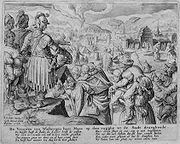
Ministerialis
Ministerialis ; a post-classical Latin word, used in English, meaning originally servitor, agent, in a broad range of senses...
from Gmünd
Schwäbisch Gmünd
Schwäbisch Gmünd is a town in the eastern part of the German state of Baden-Württemberg. With a population of around 62,000, the town is the second largest in the Ostalbkreis and the whole region of East Württemberg after Aalen...
as managers of the castle, which soon called itself after its seat "von Weinsberg" (Masters of Weinsberg) and who possessed the castle as a fiefdom
Fiefdom
A fee was the central element of feudalism and consisted of heritable lands granted under one of several varieties of feudal tenure by an overlord to a vassal who held it in fealty in return for a form of feudal allegiance and service, usually given by the...
until 1450. A settlement developed at the tendencies of the Burgberg. A settlement at the trade route in the valley served the supply of the castle and the surrounding localities. Around 1200 the building of the Johanneskirche began at instigation of the Masters of Weinsberg between these two settlements.
Presumably Weinsberg was created at the same time and surrounded with a city wall
Defensive wall
A defensive wall is a fortification used to protect a city or settlement from potential aggressors. In ancient to modern times, they were used to enclose settlements...
. In 1241 the town was first mentioned in one Staufish income list, where Weinsberg ranked at 29 equal with Donauwörth
Donauwörth
Donauwörth is a city in the German State of Bavaria , in the region of Swabia . It is said to have been founded by two fisherman where the Danube and Wörnitz rivers meet...
, Wiesbaden
Wiesbaden
Wiesbaden is a city in southwest Germany and the capital of the federal state of Hesse. It has about 275,400 inhabitants, plus approximately 10,000 United States citizens...
, Offenburg
Offenburg
Offenburg is a city located in the state of Baden-Württemberg, Germany. With about 60,000 inhabitants, it is the largest city and the capital of the Ortenaukreis.Offenburg also houses University of Applied Sciences Offenburg...
and Konstanz
Konstanz
Konstanz is a university city with approximately 80,000 inhabitants located at the western end of Lake Constance in the south-west corner of Germany, bordering Switzerland. The city houses the University of Konstanz.-Location:...
. The date of when Weinsberg attained its town privileges is unknown. However, it must have been before 1283, since Rudolf I
Rudolph I of Germany
Rudolph I was King of the Romans from 1273 until his death. He played a vital role in raising the Habsburg dynasty to a leading position among the Imperial feudal dynasties...
had lent its town privileges to Löwenstein
Löwenstein
Löwenstein is a town in the district of Heilbronn in Baden-Württemberg, Germany. It was first mentioned in 1123. The castle of Löwenstein served as a residence for the counts of Löwenstein-Wertheim. In 1634 the castle was destroyed by the imperial forces....
in this year - after the model of the city right, which its predecessors of the town Weinsberg had lent. At the beginning one half of Weinsberg was a free imperial city
Free Imperial City
In the Holy Roman Empire, a free imperial city was a city formally ruled by the emperor only — as opposed to the majority of cities in the Empire, which were governed by one of the many princes of the Empire, such as dukes or prince-bishops...
, the other half belonged to the Masters of Weinsberg. The town persisted on its status as a free imperial city and affirmed it by entrying to different city federations, what led to numerous quarrels between the town and the masters.
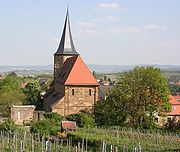
The quarrels with the masters persisted. Finally, on May 22, 1417, Sigismund
Sigismund, Holy Roman Emperor
Sigismund of Luxemburg KG was King of Hungary, of Croatia from 1387 to 1437, of Bohemia from 1419, and Holy Roman Emperor for four years from 1433 until 1437, the last Emperor of the House of Luxemburg. He was also King of Italy from 1431, and of Germany from 1411...
gave Weinsberg to his treasurer Konrad IX. So the town had been devalued by losing its status as a free imperial city to the subordinated status of the Masters of Weinsberg's rule. The town looked for protection in a further city federation called the Weinsberg Federation. On November 27, 1420, 33 free imperial cities united for the protection of Weinsberg.
The town refused to acknowledge Konrad's rule and didn't want to pay its taxes any longer. That's why Konrad IX achieved the Reichsacht at the royal court imposing on all citizens of age on 10 February 1422. Since it had caused nothing the Aberacht followed in 1425. In addition the Pope - presumably Martin V
Pope Martin V
Pope Martin V , born Odo Colonna, was Pope from 1417 to 1431. His election effectively ended the Western Schism .-Biography:...
- imposed the anathema
Anathema
Anathema originally meant something lifted up as an offering to the gods; it later evolved to mean:...
on them in 1424. However, all this hadn't caused anything, and Konrad took drastic steps. Weakening the Swabian towns allied with Weinsberg, he acquired the town Sinsheim
Sinsheim
Sinsheim is a town in southwestern Germany, in the Rhine Neckar Area of the state Baden-Württemberg about 22 kilometers southeast of Heidelberg and about 28 kilometers northwest of Heilbronn in the district Rhein-Neckar. It consists of a city center and 11 suburbs with a total population of 35,605...
, where one of the arteries led to the Frankfurt Trade Fair
Frankfurt Trade Fair
Frankfurt Trade Fair , with 448,000,000 Euros in sales and over 1,600 active employees, is one of the world's largest trade fair companies. The group has a global network of 28 subsidiaries, five branch offices, and 52 international sales partners. Thus, the Messe Frankfurt is present in over 150...
. In August 1428 he attacked businessmen in Sinsheim travelling to the fair and detained 149 people from 20 cities, so the Frankfurt fair had to fail. The king took it as personal offense and withdrew his favour from Konrad. In October 1428 the cities agreed with Konrad in Heidelberg
Heidelberg
-Early history:Between 600,000 and 200,000 years ago, "Heidelberg Man" died at nearby Mauer. His jaw bone was discovered in 1907; with scientific dating, his remains were determined to be the earliest evidence of human life in Europe. In the 5th century BC, a Celtic fortress of refuge and place of...
, however the king forbade this agreement. Two years later, the parties reached an agreement on basis of the obtained agreement two years before. According to the corresponding treaty Konrad had to recognize Weinsberg as a (undivided) free imperial city.
16th until 19th century
The German religious reformer Johannes OecolampadiusJohannes Oecolampadius
Johannes Œcolampadius was a German religious reformer. His real name was Hussgen or Heussgen .-Life:He was born in Weinsberg, then part of the Electoral Palatinate...
was born here in 1482 and was a preacher at the local church from 1510 to 1518, the year in which he went to Basel
Basel
Basel or Basle In the national languages of Switzerland the city is also known as Bâle , Basilea and Basilea is Switzerland's third most populous city with about 166,000 inhabitants. Located where the Swiss, French and German borders meet, Basel also has suburbs in France and Germany...
, where he introduced the reformation
Protestant Reformation
The Protestant Reformation was a 16th-century split within Western Christianity initiated by Martin Luther, John Calvin and other early Protestants. The efforts of the self-described "reformers", who objected to the doctrines, rituals and ecclesiastical structure of the Roman Catholic Church, led...
.
On April 16, 1525 (Easter Sunday), during the German Peasants' War
German Peasants' War
The German Peasants' War or Great Peasants' Revolt was a widespread popular revolt in the German-speaking areas of Central Europe, 1524–1526. At its height in the spring and summer of 1525, the conflict involved an estimated 300,000 peasants: contemporary estimates put the dead at 100,000...
, the peasants attacked and destroyed the castle, which was already damaged from an earlier attack in 1504. They then proceeded to execute the nobleman who had been in command of both town and castle and who had treated the peasants very badly several times before. The execution was an unprecedented move and shocked and outraged the German nobility and clergy. They had the town destroyed several weeks later, on May 21, even though the townspeople had had nothing to do with the execution.
From 1819 until his death in 1862, the poet and physician Justinus Kerner
Justinus Kerner
Justinus Andreas Christian Kerner was a German poet and medical writer.-Life:He was born at Ludwigsburg in Württemberg...
lived in Weinsberg. His circle of friends, all of them poets, often met at his house, giving Weinsberg the reputation of being a "Swabian Weimar".
Time until World War II
During the Second World WarWorld War II
World War II, or the Second World War , was a global conflict lasting from 1939 to 1945, involving most of the world's nations—including all of the great powers—eventually forming two opposing military alliances: the Allies and the Axis...
, Weinsberg was the site of a prison camp for Allied officers (French and British). On April 12, 1945, the town was destroyed by aerial bombings, gunfire and the fires which resulted from this.
Twin Towns
Weinsberg has official partnerships with the French town of CarignanCarignan, Ardennes
Carignan is a commune in the Ardennes department in northern France. It is the seat of a canton.-History:Carignan was, under the name Epoissium, Eposium, Epusum or Ivosium, a military settlement of the Romans. Gaugericus, bishop of Cambrai, was born in Eposium around 550. As Yvois, it was part of...
(département Ardennes
Ardennes (département)
Ardennes is a department in the northeast part of France named after the Ardennes area.- History :The department is one of the original 83 departments created during the French Revolution on 4 March 1790. It was named after the Ardennes hills, which are located in northeast France, southern...
) and the Italian town of Costigliole d'Asti
Costigliole d'Asti
Costigliole d’Asti is a small Italian town in the Province of Asti, southern Piedmont. It lies about 13 km south of the city of Asti in the Alto Monferrato, on the edge of the Langhe, in the alluvial plain of the river Tanaro southwards into the hills....
(Province of Asti
Province of Asti
The Province of Asti is a province in the Piedmont region of northern Italy. Its capital is the city of Asti. To the north west it borders on the province of Turin; to the south west it borders on the province of Cuneo. To the east it borders on the province of Alessandria, while in the south it...
). There are informal relations with Cossebaude (now a part of Dresden
Dresden
Dresden is the capital city of the Free State of Saxony in Germany. It is situated in a valley on the River Elbe, near the Czech border. The Dresden conurbation is part of the Saxon Triangle metropolitan area....
) in Germany, Keyworth
Keyworth
Keyworth is a village and civil parish in Nottinghamshire, England. It is located about 6 miles southeast of the centre of Nottingham...
(Nottinghamshire
Nottinghamshire
Nottinghamshire is a county in the East Midlands of England, bordering South Yorkshire to the north-west, Lincolnshire to the east, Leicestershire to the south, and Derbyshire to the west...
) in the UK and Lake Crystal, Minnesota
Lake Crystal, Minnesota
Lake Crystal is a city in Blue Earth County, Minnesota, United States. The population was 2,549 at the 2010 census. It is part of the Mankato–North Mankato Metropolitan Statistical Area.-Geography:...
in the US. The latter two came about because of student exchange programs between schools in Weinsberg and schools there.
The American town of Winesburg, Ohio
Winesburg, Ohio
Winesburg is an unincorporated community in southwestern Paint Township, Holmes County, Ohio, United States. The town sits on the crest of a hill in the Amish country of Ohio, with a quaint downtown containing antique shops. It lies along U.S. Route 62....
was originally named after Weinsberg in the early 19th century and had the spelling changed only in 1833.
Wine growing
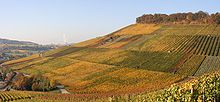
Viticulture
Viticulture is the science, production and study of grapes which deals with the series of events that occur in the vineyard. When the grapes are used for winemaking, it is also known as viniculture...
has been the basis of Weinsberg's economy and plays still an important role. In 1271 viticulture in Weinsberg was mentioned for the first time, there are proven 28 wine-presses in the town from 1636. With a cultivated area of 430 ha (conditions: 2005, with districts), two thirds of it are red wine sorts, standing the town in fifth place of the viticulture municipalities in Württemberg
Württemberg
Württemberg , formerly known as Wirtemberg or Wurtemberg, is an area and a former state in southwestern Germany, including parts of the regions Swabia and Franconia....
. In 1868 the winemaking cooperative Weinsberg was created, getting fusioned with Erlenbach's and Heilbronn's cooperatives to the Genossenschaftskellerei Heilbronn-Erlenbach-Weinsberg e. G., still attaching the most wine-growers of Weinsberg. In addition there are some estates removing and marketing their wine by themselves. Besides there's the Staatliche Lehr- und Versuchsanstalt für Wein- und Obstbau (LVWO or briefly viticulture school) created in 1868, educating people and marketing their wine as Staatsweingut Weinsberg. Since January 19, 1957, there's also the technical school of cooper
Cooper (profession)
Traditionally, a cooper is someone who makes wooden staved vessels of a conical form, of greater length than breadth, bound together with hoops and possessing flat ends or heads...
business accomplishing courses each year to a mastership examination
Chamber of commerce
A chamber of commerce is a form of business network, e.g., a local organization of businesses whose goal is to further the interests of businesses. Business owners in towns and cities form these local societies to advocate on behalf of the business community...
in this profession. Finally since 1972 also the viticulture association of Württemberg resides in Weinsberg.
Traffic

Bundesautobahn 6
, also known as Via Carolina is a 477 km long German autobahn. It starts at the French border near Saarbrücken in the west and end at the Czech border near Waidhaus in the east....
(Mannheim
Mannheim
Mannheim is a city in southwestern Germany. With about 315,000 inhabitants, Mannheim is the second-largest city in the Bundesland of Baden-Württemberg, following the capital city of Stuttgart....
-Nuremberg
Nuremberg
Nuremberg[p] is a city in the German state of Bavaria, in the administrative region of Middle Franconia. Situated on the Pegnitz river and the Rhine–Main–Danube Canal, it is located about north of Munich and is Franconia's largest city. The population is 505,664...
) and A 81
Bundesautobahn 81
is a motorway in Germany. It branches off the A 3 at the Würzburg-West triangle and ends near the border to Switzerland.The oldest part of the A 81 between the Weinsberg intersection near Heilbronn and the Leonberg triangle near Stuttgart was finished in the years 1938 to 1940...
(Würzburg
Würzburg
Würzburg is a city in the region of Franconia which lies in the northern tip of Bavaria, Germany. Located at the Main River, it is the capital of the Regierungsbezirk Lower Franconia. The regional dialect is Franconian....
-Stuttgart
Stuttgart
Stuttgart is the capital of the state of Baden-Württemberg in southern Germany. The sixth-largest city in Germany, Stuttgart has a population of 600,038 while the metropolitan area has a population of 5.3 million ....
) cross there. The A 81 to Würzburg is less busy than the other three directions. Due to the opening of the Eastern Bloc
Eastern bloc
The term Eastern Bloc or Communist Bloc refers to the former communist states of Eastern and Central Europe, generally the Soviet Union and the countries of the Warsaw Pact...
, the A 6 leading in east-west direction is often a gridlock. In 2001, the daily traffic volume got up to 102,000 vehicles. 30% of it are HGV, so it‘s one of the highest portions in the German motorway net. For a long time, the extension to six lanes of the four-lane A 6 is an urgent desire of the whole Heilbronn region. It has paid the costs of the expansion plan from Weinsberg interchange up to the Bavarian border. The extension is assured but not scheduled yet, so as a remedy the shoulders of the motorway became provisional driving strips.
Formerly the Bundesstraße
Bundesstraße
Bundesstraße , abbreviated B, is the denotation for German and Austrian national highways.-Germany:...
39 (Heilbronn-Schwäbisch Hall
Schwäbisch Hall
Schwäbisch Hall is a town in the German state of Baden-Württemberg and capital of the district of Schwäbisch Hall. The town is located in the valley of the river Kocher in the north-eastern part of Baden-Württemberg....
) leading in west-east direction had been running right through the town, dividing Weinsberg into a northern and southern part. Crossing the B 39 apart of traffic lights was nearly impossible, so the desire of a by-pass grew, which was finally inaugurated on July 13, 1990. Running from Heilbronn it passes the Schemelsberg in a tunnel, then it leads around Weinsberg parallel to the A 6 and finally meets the old B 39 in the east. The old route of the B 39 through the town got traffic-calmed. At the border to Ellhofen the motorway feeder B 39a branches to the south, which leads to the A 81‘s motorway junction Weinsberg/Ellhofen.
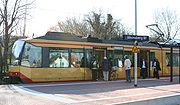
Tram-train
A tram-train is a light-rail public transport system where trams run both on an urban tramway network and on main-line railways to combine the tram's flexibility and availability and the train's greater speed...
s operated by the Heilbronn and Karlsruhe Stadtbahns and buses co-ordinated with it by the HNV
Heilbronner Hohenloher Haller Nahverkehr
The Heilbronner Hohenloher Haller Nahverkehr is a regional transport cooperative that coordinates tickets and fares among all transport operators in the metropolitan area of Heilbronn in Germany. Besides the city of Heilbronn, the H3NV area encompasses the districts of Heilbronn and Hohenlohe...
. Weinsberg is situated on the Hohenlohebahn rail track built from 1860 to 1862 running from Heilbronn via Öhringen
Öhringen
Öhringen is the largest city in Hohenlohe in the state of Baden-Württemberg, in southwest Germany, near Heilbronn. Öhringen is on the railways to Schwäbisch Hall and Crailsheim.With a population of 22,745 , the city is diverse...
to Schwäbisch Hall. Apart from Regional-Express trains of the Deutsche Bahn
Deutsche Bahn
Deutsche Bahn AG is the German national railway company, a private joint stock company . Headquartered in Berlin, it came into existence in 1994 as the successor to the former state railways of Germany, the Deutsche Bundesbahn of West Germany and the Deutsche Reichsbahn of East Germany...
, the Albtal-Verkehrs-Gesellschaft
Albtal-Verkehrs-Gesellschaft
The Albtal-Verkehrs-Gesellschaft is a company, which is owned 100% by the city of Karlsruhe and operates rail and bus services in the Karlsruhe area....
runs its tram-trains there to Öhringen since December 2005. Nothing had been invested to this previous non-electrified distance for a long time, still being on technical conditions of 1900. For this purpose the track became modernized until Öhringen from 2003 to 2005 providing an overhead line for the first time. In addition new train stops were opened. In Weinsberg they‘re called Weinsberg-West (planned start February 2009) and Weinsberg/Ellhofen Industriegebiet (since December 2006), so that Weinsberg will have three stops at its disposal.

